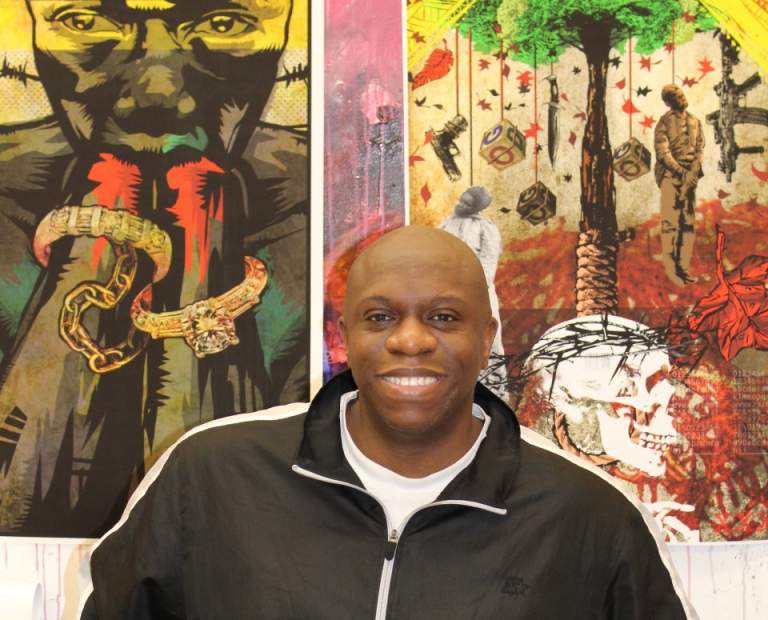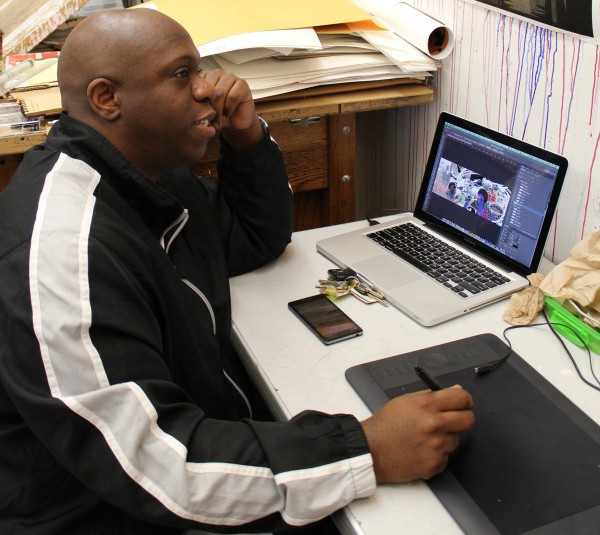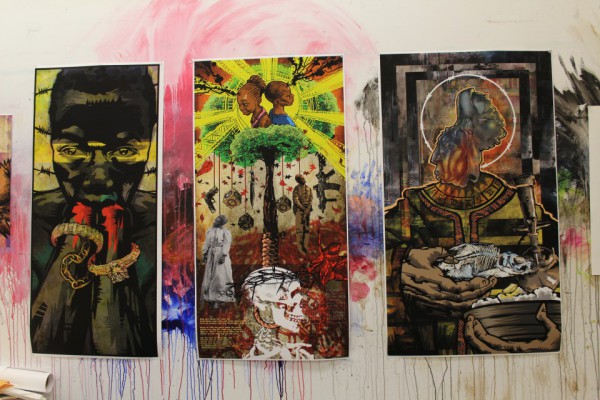
Teaching artist Stacey Robinson in studio.
Justice & Opportunity
Partner Spotlight: Stacey Robinson
Published October 8, 2015
By Adrienne C. Hill
Scribe, Open Buffalo
Above the desk in Stacey Robinson’s art studio at University at Buffalo hangs a piece called “Money Tree.” The digital drawing, Robinson explains, uses lynching as a metaphor for the various social forces that police black bodies, and it is the visual equivalent of a punch in the gut. The centerpiece of the drawing is a tree, blood on the leaves, bodies hanging from its limbs alongside guns, knives, and children’s building blocks with the word “GOD” on them. The root of the tree is a noose, and it hangs around the neck of a grinning skeleton, a crown of thorns around its head, and a barcode emblazoned on the side.
Robinson explains the skeleton: “All skeletons are white. But outside of those skeletons dictates everything in our lives. I was thinking about how we all revert back to this very white skeleton, this thing where you can’t even tell—you have to do genetic testing on to even figure out an ethnicity for.” He is also quick to point out moments of joy and hope within trauma represented by the top of the painting, where a sun rises above the tree, and two black children—Robinson’s kids—emerge, smiling in opposite directions.
Underneath “Money Tree,” Robinson sits at his desk, putting the finishing touches on “Building the Black Utopia,” his final piece for Binary ConScience, his Master of Fine Arts (MFA) thesis exhibition. He explains that envisioning black utopias, or what he sometimes calls “spaces of peace,” has long been a preoccupation of his art. It is, in fact, the work he set out to continue doing when he came to Buffalo from Fayetteville, North Carolina, until conversations with his professors convinced him that he could not fully envision black utopia without first making art that addressed the ongoing legacy of black trauma. “Building the Black Utopia” will appear at the end of Binary ConScience, only after its audience has done the work of facing black trauma, and struggling to find smaller, more fleeting spaces of peace in the midst of that trauma.
Robinson talks about his upcoming exhibition in a sprawling, two-hour conversation while he continues to work on “Building the Black Utopia.” He talks about his struggles to portray both black trauma and visions of black utopia, about the joys and challenges of being a politically conscious black artist in Buffalo, about his decision to stay in Buffalo following the completion of his MFA, and the legacy he hopes to leave in this city through his art.
_______________________________________
Open Buffalo: How long has black trauma been the focus of your work?
Stacey Robinson: Definitely two years. I’ve had the ability to actually deal with it here. I moved up from North Carolina, and some of those spaces don’t typically deal with black pain, because they have to deal with their past. And they don’t deal with the past. So I get [to UB], and then I actually have faculty that can not only help me deal with it, but they can also have a conversation. And I wasn’t able to do that before. It was really exactly what I needed for grad school.
So, for the past two years, I’ve been making work that is dealing specifically with what I’ve been wanting to talk about. I can actually take my time, and really talk about, you know, “Why do we need this space?” And I’m even dealing with ideas of, “What is black in 2015?” As soon as Obama was elected, there became this vocabulary of “post-racial.” And then there’s Ferguson.
OB: How do you think your work addresses black trauma?
SR: My work is not really about giving the answers. It’s about asking questions. I want to be arrogant enough to be able to say, “This is how you free black people.” (Laughs.) You know? And I want to be able to say that, but I’ve had professors who’ve sat me down and said, “You cannot say that. You cannot say that you have the answer.”
Because, as heartfelt as my sincerity is in really talking about these issues, and really wanting to deal with the ideas of slavery and freedom, I cannot just say, “This is what it is, this is what we need to do to be free.” Everything I’m making is about the conversation. I’m not trying to be a dictator. (Laughs.) But honestly, I still struggle with that, even with making this work. Innately, I want to force people to be free. And I just can’t do that.
I cannot force people to see. I can’t even get people to see that we are still in a colonial space. And that’s not just black people. It is, if you are not the “1 percent,” you are a slave. When you don’t have money, you are a slave, you know? It’s really hard to even get people to see.
When I think about Malcolm, and Martin, or any of my heroes, they had wonderful ideas, and presented those ideas. They presented strategies. But they did not, they were not able to, make people be free.
OB: It sounds like the more you do this art, the more you delve into black trauma, the more you realize there are no easy answers. But, you’re working on a piece called “Building a Black Utopia.” So in the midst of all this frustration, you still seem to have a vision of things turning out OK.
SR: And I do. So, one of the things that I was talking about with a student this morning was, he was really starting to find himself artistically. And it was awesome. He was going to give up — he was going to change his major to focus on something that was more financially promising. And I was like, “OK,” but I knew he was an art major. He needed to be making art. And I could not tell him, “No, you should do this.” It’s not my place to, right? However, he found that himself.
To me, that’s a sense of utopia. You know, for him to be able to find his voice, his place.
So when I’m talking about utopias, I will take any utopia that I can get, at any time. If it is a student who finds his purpose in life, and connects with me because I taught a class. Or if it’s my very white faculty, who give me all of this information to read, and say, “Now, go build something with it.” I will take whatever utopia I can get, because what I’m actually getting, I can now go and give.
OB: So for you, utopia, black or otherwise, is not an end to strive for. It’s temporary spaces you find while you strive.
SR: I’m thinking about it like, this is the physical space. But I’m also looking at spaces of peace that do exist.
As artists, we’re always building utopias. And sometimes I feel like I’m thinking about it too heavily. It’s like I can connect to the community, and we can make temporary utopias. Spaces of peace. Spaces of conversation. And people do it all the time. A barbeque. A jazz event. A picnic. A birthday party. A book reading. You know? These are all things that have been done, that honestly have been proven to be successful.
But my concern is, how do we enforce this change? Why is Buffalo segregated when there are all these? I love Allentown, for example, but I’m one of the only black faces I see in Allentown. But where else would I live? It’s the artists’ community. That’s where all the galleries are. But it also makes me think, “Where are the other Black artists?”
OB: How do you continue to make to make politically conscious, emotionally difficult work, despite the ambiguities and frustrations it generates?
SR: [One question I ask myself is,] as a black artist, can I just make work that does not deal with the black experience? Can I just make some fun abstract work that is not political? I’ve been arguing with myself for years about this.
I’ll share one of the secrets of being a black artist. One of the things that we struggle with a lot of times is, “Am I an artist, or am I a black artist?" In a space where your melanin count identifies you, this is a question that you have to be cognizant of, regardless of the answer that you come up with. And I believe it’s always personal.
I identify as an artist before I identify as black. Everybody probably won’t do that. “Black” is a new term. It was “negro,” it was “African-American,” it was “colored,” it was—all these things. But I will always be an artist. I will always be a person with a high melanin count.
In that, my work always has to be political. Do I make abstract stuff that’s just fun, too? Yes. I’ve actually tried that. I painted one thing in the last several years — no politics involved at all. It was just colors, abstraction. And I have no affection for that piece at all. None.
I think my work always has to be political. And I think that is because of our relationship to America. Everything is political. The politics of being in this space have dictated what my subject matter is. My subject matter is always the same. It is always about black liberation. I don’t know how to paint or draw anything that is not associated with that. I have no idea.
OB: One of the things your art seems to say is that we can center black experience, and we can universalize it.
SR: One of the questions that I’m glad I don’t get a lot is, “You don’t paint white people?” I’ve gotten that question before, in the South. (Laughs.) And I love the question. It’s an honest question, and I know where it comes from. Because I know what we learn. We learn that white is the privilege, and if you don’t have it, the attainment of acceptance from whiteness is the ultimate goal.
I think [my work] opens up the conversation. And I think my work is universal. I think that my work can be exclusively black, talk about the black experience, and be very universal. Because many of the things that we’re talking about, they go beyond that. The things that I’m talking about go beyond ethnicity. I’m talking about poverty. I’m talking about utopias. And yes, I’m talking specifically about the black experience, but we all know about lack of peace.
OB: You’ve decided to remain in Buffalo after completing your MFA. To what extent is your understanding of black trauma, and its connections to black utopia, informed by this city?
SR: I’m working at Buffalo Arts Studio … with the Jump Start program. I’m very fortunate that this is the best group of kids that I’ve ever worked with. But when I look at the community that I’m really wanting to service, I’m realizing that these kids are the best of the best. It takes a lot to even be part of this program. You have to prove your dedication. These kids are gifted.
But, that’s right there on Main Street. And these kids are coming from all over. If I were to walk two blocks [in] any direction of Main Street, I am in the hood. From Main Street to there, it looks like two different cities. How can this exist two spaces apart? And then when I’m over there, all the white faces disappear. It is clearly segregated. When I first moved here, I didn’t realize this was the face of Buffalo.
I’m talking about black spaces; I’m talking about black utopias, I’m talking about black trauma. How do I get the hood to come to the art space? This space is segregated for them. First of all, in order to collect art, you have to have residual income. Most people don’t have that, regardless of ethnicity. But how do I engage the hood enough with my artwork to want to come to my show?
How do I bring the show to the hood? That is a harder question. You can get buses and go to a community and say, “Hey, we’ve got this going on,” and bring them to the show. That is almost an easier thing to do than to be able to go to the hood, make a show, and then invite people to it. I don’t know how to do that. That’s part of the reason I want to connect [to Open Buffalo and other organizations], because your organization will know more about Buffalo than I know.
One of the things I’ve learned is that I don’t have to reinvent the wheel, and I don’t have to do everything myself. That connecting and partnering with organizations who are fighting the same fights, whose specialties are in other areas, allows me to be able to take my voice to places that I wouldn’t have been able to be able to do before.

OB: What do you think organizations like Open Buffalo can do to help artists like you open up difficult conversations about things like racism, trauma, and poverty, and to “bring art to the hood”?
SR: What I’m thinking about is changing lives. Not necessarily changing landscapes as much. If you change people’s lives, they’ll change their landscapes. I really am concerned about educating, and what does my audience need to know? What do they need to be introduced to? What gets them to think about these life changes, and how do we empower? If we can empower — and of course, you can always empower; I really believe that — how do we go about doing that? What resources are needed?
Honestly, it’s so new to me, this connection to Buffalo. I’m more interested in literally just talking, listening, sitting down with people, and saying, “OK, this is what our organization does, and this is how you can help.”
OB: What does the term “Open Buffalo” mean to you? What would a Buffalo that is truly open look like to you?
SR: That’s a really good question. I went to an artists’ talk last night, and it took place in a person’s home. And it was beautiful. It was like, oh my god, she actually built a space of peace in her house, for artists to come and present their work over food and drink. Simple concept, right? It doesn’t take a genius to do that, but it takes a very special person to open up your home to people you don’t know, and to say, “Hey, come talk about art, have food, and I trust you.”
A very open space — a very open Buffalo — would be a place where you can do exactly that. And I’m speaking metaphorically. I’m not saying, “Every house is open, come on in!” But I’m saying that conversations could actually take place under a very open Buffalo.
In a very open Buffalo, there is a potential for finances to change. People don’t have to, or they choose to, live in their community, whatever their communities are, but there are resources. You know, that’s a very open Buffalo to me. If there’s not an equal distribution of access, as well as resources, there is no “open.”
When you have segregation, the whole point of segregation is to close off. Right? It is a closed Buffalo. I don’t believe things happen by accident. Those spaces are designed. And I think they function very well. How do you change that? And then when you’re talking about that, you’re really talking about changing finances. How do you change the finances of a segregated city? How do we get the people who are clearly living in poverty out of poverty?
[Having conversations about these questions] is what an open Buffalo would be to me. Because it’s not just about my ideas for Buffalo. It’s about our ideas for Buffalo.
_______________________________________
Stacey Robinson’s first solo exhibition, Binary ConScience, ran from March 27 through May 2, 2015, at Buffalo Arts Studio, alongside Megan Conley’s Assemblage and works by members of BAS’s Jump Start program for youth. The event attracted a diverse crowd, with hundreds of Buffalonians, young and old, enjoying stimulating visual art, a pulsing soundrack provided by a live DJ, and refreshments -- all in the safe space that Robinson's passion and art had created. Opening night visitors also participated in an “Open Buffalo Dream Wall."
Robinson currently sits on Open Buffalo’s Leadership Development Committee, which oversees the Emerging Leaders program and the creation of other local skill-building workshops.
